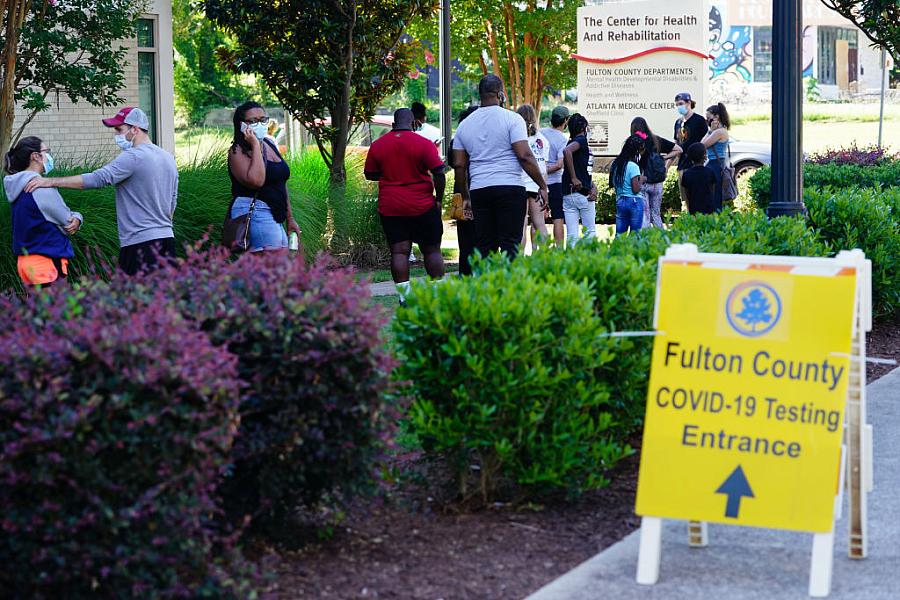America’s ‘medically fragile’ left to fend for themselves amid pandemic

People stand in line to get tested for COVID-19 at a free walk-up testing site on July 11, 2020 in Atlanta, Georgia (Photo by Elijah Nouvelage/Getty Images)
Vaccine frenzy hit my friend group in December. Health care workers were eligible first, and my colleagues at the practice where I work rushed to find appointments and post vaccine selfies. I got a vaccine, too, but unlike my friends, I knew there was a good chance it wouldn’t work.
I am one of the 10 million people in the United States who is immunocompromised. In March 2020, we were put on high alert. The groups that were most likely to die of COVID-19 were the elderly, the obese, those with serious heart and lung disease and the immunocompromised.
I have a congenital immunodeficiency, and before the COVID-19 pandemic, I’d already been sick with infections countless times. As the virus spread across the country last spring, I closed my practice to all but emergencies and switched to telemedicine. My daughter came home from college. My high schooler switched to remote school, and my husband began working from home. On April 2, 2020, the governor of Georgia issued a stay at home order. Four weeks later, he lifted it except for the elderly and “medically fragile,” who were ordered to continue sheltering in place.
The governor gave no guidance on exactly how the medically fragile were supposed to remain isolated. There was no acknowledgement that the medically fragile do not live alone, that almost all of us have jobs and responsibilities and families. The greatest fallacy was the suggestion that such sheltering was even possible for many of America’s most vulnerable people.
My family was fortunate to be able to comply with the order. My daughters cut themselves off from their friends. My 20-year-old spent two weeks isolating in the basement when she got home from college and then could not see her friends for fear of exposing me to Covid. Once my younger daughter’s high school returned to a hybrid model, my health prevented her from returning to school. A report from New York showed an estimated 25% mortality for people with my particular disease. Virtual school was challenging enough; hybrid school was worse. My daughter sank into depression. My husband was able to work from home and support her, but we all struggled.
By May, I had to go back to work or declare my medical practice bankrupt. I had no choice. I donned PPE, a face shield, one of only a few precious N95s, and I worked.
But other medically fragile people were not able to isolate or protect themselves, and it cost them their lives. A hypertensive respiratory therapist with end-stage renal disease got COVID-19 and died. A young woman who worked in a grocery store brought COVID home, and both her parents died. Across the nation and my own state of Georgia, hundreds of thousands of the medically fragile people were exposed and died.
It was possible to protect us. But our government made a choice to let us die when they could have made sure that anyone who lived with a vulnerable person had adequate PPE or a safe area to work, or better yet, could work from home. They could have installed ventilation systems in schools or had dedicated virtual school programs for kids with high-risk relatives in the house. They could have prioritized COVID-19 testing for people whose family members were high risk, with dedicated housing for positive patients who did not require hospitalization. All these supports were available in other countries. But in the U.S., our local and state governments and health authorities blamed the dead and dying — for being old, diabetic, overweight, for having cancer, for being weak. They deemed us all acceptable losses. We were not the deplorables. We were the disposables.
Since I had a history of not responding to other vaccines, my immunologist told me to check spike antibodies a month after my second dose of vaccine. When I saw my lab results and realized that the vaccine did not work, I sat down on the floor and sobbed for the first time that whole long year. I could not wear PPE forever. My children and my husband could not isolate forever. My vaccinated friends were posting pictures of champagne popping, hugging their parents, celebrations all around, but not for us.
My immunologist reassured me that in a year there would probably be protective antibodies in the antibody infusions I get monthly. In a year.
I am now on monthly prophylactic monoclonal antibodies, and likely as protected as a vaccinated person, but I am still distressed when I see reports reassuring vaccinated patients about what they are now free to do — Take off your mask! Travel! Dine indoors with vaccinated people!
Immunocompromised patients were not included in the clinical trials for vaccines. We still have minimal knowledge as to how well the vaccines protect this population. It seems the plan right now is to sit back and see who gets sick. There is almost no proactive work being done, and no nuance in advice given to vaccinated people. We will be useful statistics, acceptable losses. Disposable.

